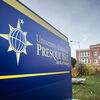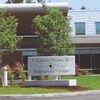Processing Your Payment
Please do not leave this page until complete. This can take a few moments.
Fishing for a future, part 2 | Facing mounting costs and restricted access, Maine fishermen find new opportunities in a growing aquaculture industry
Read part one of this series, which appeared in the Jan. 25 issue.
A man in orange and black foul-weather gear turns from the side of the barge with a net full of cod, dumping them onto a wooden table. The cod — green with white bellies — jump and jerk, shocked by their sudden removal from the gray water of Frenchman Bay.
At the edge of the table, another man wearing the same gear, a cigarette dangling from his lips, grabs one of the flailing fish with a gloved hand. He picks it up and turns it over, belly up. In the other hand he holds a blue-handled tagging gun, essentially a long needle with a trigger that inserts a plastic barb and small ID tag. The man — a former lobsterman named Richard Davies — shoves the needle through the cod’s lower lip and pulls the trigger. Thunk. He tosses the tagged cod into a water-filled bucket at the end of the table. Officials in New York, where this batch of cod is headed, will now be able to identify this fish as farm-raised by GreatBay Aquaculture in Sorrento, Maine.
Davies, an inch of ash extending from the tip of his cigarette, reaches for another cod.
Overseeing the harvest is Clayton Coffin, who manages this cod farm — the only one in the country — for Portsmouth, N.H.-based GreatBay Aquaculture. Coffin, bundled in a red jacket and orange foul-weather bib pants, stands next to the scale where the bucket, drained of water, is brought once it contains a dozen cod.
Each cod harvested on this January day is 18 months old, roughly 18 inches long and weighs close to two pounds. After Coffin records the weight and number of fish, they are dumped into a gray plastic tub full of seawater pumped from the bay. There are six of these tubs on the deck, each of which holds approximately 360 pounds of live cod. Two are bound for Boston and four for New York City. All are bound for the Asian restaurant market, where the cod will swim again in an aquarium before being chosen by a hungry customer to be steamed and served.
Coffin, 47, has worked in aquaculture for most of the past 15 years. Before that, he fished for lobster and scallops, something he’d done since he was 14 and something his father and grandfather had done before him. He made the jump to aquaculture because he found making a living as a fisherman harder and harder to do. It wasn’t because the lobster or scallops were getting scarce, he says, but because the cost of searching for them kept rising, from increasing diesel costs to the added burden of more regulations. In 15 years, the price of scallops never wandered far from $6.50 a pound, but his costs in that time tripled, he says. “It didn’t take long, but it really hurt in the wallet.”
Much of the growth in Maine’s aquaculture industry has come from former fishermen like Coffin who turned to aquaculture as a new opportunity to use their skills to continue making a living on the water. Coffin guesses that as much as 70% of the people in the local industry are former fishermen. The trend is not unique to Maine. Around the globe, the transition from fisherman to farmer is taking place as wild fisheries are reduced from overfishing or the costs of fishing increase.
Coffin’s estimate about the makeup of Maine’s aquaculture industry seems spot on. According to Sebastian Belle, director of the Maine Aquaculture Association, more than 75% of the association’s members are former commercial fishermen, or the sons and daughters of fishermen. Belle has seen an influx of ex-fishermen into the aquaculture sector over the last several years. Some make the wholesale switch to farmer, while others raise oysters or mussels to supplement their fishing income. “I think that this is a trend you will see more and more of in Maine,” Belle says at his Hallowell office. “We’re seeing that traditional fishing families in Maine are having a hard time getting access to the fisheries, because the fisheries have basically been overfished and controlled measures are being put in place to try and restrict harvesting, so the only way for folks from those kinds of families to continue to make a living on the water is essentially aquaculture.”
With the last cod pulled from the water and his cigarette extinguished, Davies says more fishermen will turn to aquaculture. “I think lobstering is going downhill rapidly,” he says. “I think fish farming is the key. I think there’s a bright future in fish farming.”
Dramatic growth
In any given year, there are between 140 and 150 permitted fish farms along the Maine coast. Fish farmers lease roughly 1,300 acres in state waters, with about one-third lying fallow every year. Maine aquaculture sales are between $75 million and $100 million annually, placing it consistently in the top three states with California and Hawaii in terms of aquaculture production, according to Belle. If considered an agricultural product and ranked by per acre value, salmon ($80,000 to $90,000 per acre) and shellfish ($12,000 to $16,000 per acre) turn out to be the two most valuable agricultural products in the state, Belle says.
The Maine Aquaculture Association, in existence for 30 years, now has 150 members, from large companies like New Brunswick-based Cooke Aquaculture, which dominates the state’s salmon farming, to shellfish farmers who grow oysters on a few acres.
At the moment, it’s those small-scale shellfish farmers who are driving growth in Maine’s aquaculture industry. Shellfish farming in the state is growing at between 8% and 10% every year in terms of acres, according to Belle.
One reason behind the growth of small-scale shellfish farmers stems from a decision by the Maine Department of Marine Resources in 2004 to streamline the process for farmers to obtain the state’s permission to farm fish. It created limited-purpose aquaculture licenses, which are used only for shellfish operations. The decision lowered the barrier of entry for small entrepreneurs by removing the often costly and time-consuming process of filing a lengthy application and holding public hearings, according to Diantha Robinson, aquaculture administrator at the DMR.
Getting that license is much easier, but it limits the type of shellfish that can be harvested and lasts only a year, after which it can be renewed. In 2008, Robinson approved 30 limited-purpose aquaculture licenses in the state. Already, within the first month of 2010, she had nearly 70 licenses on her desk, including renewals and new applications. “People like them because they’re cheaper, quicker, easier and don’t have a lot of public process associated with them, and they’re pretty flexible,” she says.
Many of these small-scale shellfish farmers are commercial fishermen looking to diversify their incomes. Belle says over the last five years, 75% of the calls to his association have come from commercial fishermen interested in aquaculture.
Maine’s aquaculture industry is also young. The average age in the industry in Maine is 36, Belle says, compared to 57 in the commercial fishing industry. “[We] have a young group of dynamic, creative people looking for business solutions,” he says.
These entrepreneurial farmers are trying new species, such as scallops and European oysters. Cod is another new species for Maine. GreatBay Aquaculture’s 30-acre cod farm is only 18 months old. It began as an experiment, a spinoff from GreatBay’s hatchery business in New Hampshire, which has supplied fish farms around the world with lab-raised fingerlings for years. Today, it’s safe to say the experiment is a success. The Asian restaurant markets are buying as many of the harvested cod as Coffin and his crew can harvest.
One of the reasons for the demand is that the cod Coffin and his crew are harvesting would be illegal if caught in the wild because of their small size. Coffin says the legal limit for wild-caught cod is 21 inches, while the cod they’re harvesting are between 18 and 20 inches. The smaller fish are sweeter, Coffin says. “We’re not out to compete with the wild fisheries,” Coffin says. “We’re just looking to fill another market that’s open.”
As a result of the high demand, Coffin says the company plans to expand its farm, which is about 1,000 feet from shore in 80 to 90 feet of water. The current lease allows for 10 cages on 30 acres. There are five surface net pens at the farm site, as well as one AquaPod, a modular fish cage from Searsmont-based Ocean Farm Technologies that was recently stocked with young cod. GreatBay Aquaculture is the only commercial fish farm in the country that has deployed an AquaPod, which are specially designed for operating offshore in the rough conditions of the open ocean. However, Ocean Farm Technologies has found foreign markets for its AquaPods and they are now in use by offshore fish farms in Mexico, Panama and South Korea.
Coffin says four more surface net pens will be added to the site by March. The company is also applying for another 20-acre lease site on the other side of Frenchman Bay to grow the farm by another 10 cages.
When the farm started 18 months ago, Coffin was the sole employee. Now it employs five. Still, once or twice a week, someone shows up looking for a job, and most are commercial fishermen. “I’d love to hire them all, but we can only support so many,” Coffin says. He’s holding out hope that the farm’s expansion will allow him to hire a few more.
Peer acceptance
Although Maine’s aquaculture industry — mostly salmon farming, which last year recorded a harvest of 13.3 million pounds valued at $43 million — has created controversy in the past, Belle says it’s become less so. Aquaculture, he says, over the past five years has become more accepted as part of the working waterfront, from a policy point of view and, to some extent, from the public’s point of view. “So it’s the same as lobstering or commercial fishing,” Belle says. “A lot of the debate around a particular lease was often wealthy summer people who didn’t want to look or hear or smell something. It’s much more difficult for them to articulate that if it’s viewed as part of the working waterfront.”
Robinson at the Maine Department of Marine Resources offers this analogy. Suppose there were no lobstermen in Maine. No lobster boats, no colorful buoys dotting the coastal waters and snagging outboard motors, no lobster pens floating in the harbor. Then people decided to try setting traps for a crustacean that crawls on the ocean floor. The state started licensing these entrepreneurial lobster hunters and the boats and buoys began to multiply along the coast. “Can you imagine how people would react?” she asks. “Change is difficult.”
Coffin’s been through the ups and downs of the industry. These days the farms aren’t seen as nuisances by most coastal landowners, he says. He sweeps his arm toward the snow-dusted coastline of Frenchman Bay, home to some of the wealthiest neighborhoods in the state. “As long as we behave ourselves and be socially responsible, we won’t have any problems,” he says.
Leveraging technology
The presence of a single AquaPod in the water in Sorrento is evidence that fish farmers like George Nardi, chief technical officer of GreatBay Aquaculture, see farming fish far offshore as the future of the industry, even if it’s not economically viable yet.
Coffin says his crew is learning how to work with the AquaPod and is helping Steve Page, president of Ocean Farm Technologies, the manufacturer of the AquaPod, to work out the operational kinks of farming in the cold waters of the North Atlantic. The idea is to make the system as automated as possible, to reduce the need to send divers into the water to, for example, clean the cage.
In September 2003, the University of New Hampshire deployed an AquaPod six miles off the coast of New Hampshire, but still in state waters. Researchers determined an offshore fish farm is possible, but not yet economically feasible, Nardi says. Moving aquaculture offshore will happen, he says, but it’s still too early and there are still too many hurdles and too much financial risk.
But Belle doesn’t doubt that the industry will eventually move offshore. “When that happens — and I use the term ‘when’ intentionally— then those kinds of technologies ... will, I don’t have any doubt, revolutionize our industry and open a whole huge area for potential development that is just not available to us right now,” he says. “I don’t think there’s any doubt that — whether 25 years or 50 years or 100 years from now — we’re going to be operating in open ocean environments and the kinds of technology Steve is developing is going to be critical to that.”
Cooke Aquaculture, Maine’s salmon farming giant, is not ready to jump into offshore fish farming. “If it happens that someone comes up with a new idea that’s economically viable, of course we’d be interested, but it’s not the focus of our company right now,” says spokesperson Nell Halse.
Back on the barge on Frenchman Bay, Coffin says he doesn’t necessarily like the idea of farming fish offshore — “I spent a lot of my time offshore,” he says. “It ain’t fun” — but he recognizes it will be necessary, which is why he’s training his crew on the AquaPod, so that they can find efficiencies and tweak the design in collaboration with Ocean Farm Technologies. When the economics fall into place, Coffin and his crew will be ready to take the farm offshore and deal with the elements. “Mother Nature sets the standard,” Coffin says. “You got to play by her rules.”
Whit Richardson, a writer based in Friendship and former Mainebiz editor, reported this story through a World Affairs fellowship from the International Center for Journalists in Washington, D.C., which is funded by the Ethics and Excellence in Journalism Foundation.
GreatBay Aquaculture
153 Gosling Road, Portsmouth, N.H.
Co-founder and chief technical officer: George Nardi
Products: Its hatchery in New Hampshire provides juvenile fish, including cod, cobia and black sea bass, to fish farms around the world. It also started an experimental cod farm in Sorrento, Maine, in 2008.
Maine cod harvest, 2009: Exceeded 20,000 pounds
Employees in Maine: 5
Contact: 603-430-8057
www.greatbayaquaculture.com















Comments